When I was in high school and college, I always had a monthly membership at a local tanning salon.
Not only did I want that coveted sun-kissed glow, especially during the colder months when natural sunlight is scarce, but it also helped clear up my acne thanks to helping me go from oily skin to dry skin.
Today, I won’t step in a tanning bed and opt for spray tans instead, but you may want to minimize potential risks when tanning.
Tanning lotions have become popular in the tanning process. Some act as tan extenders in addition to protection from UV rays.
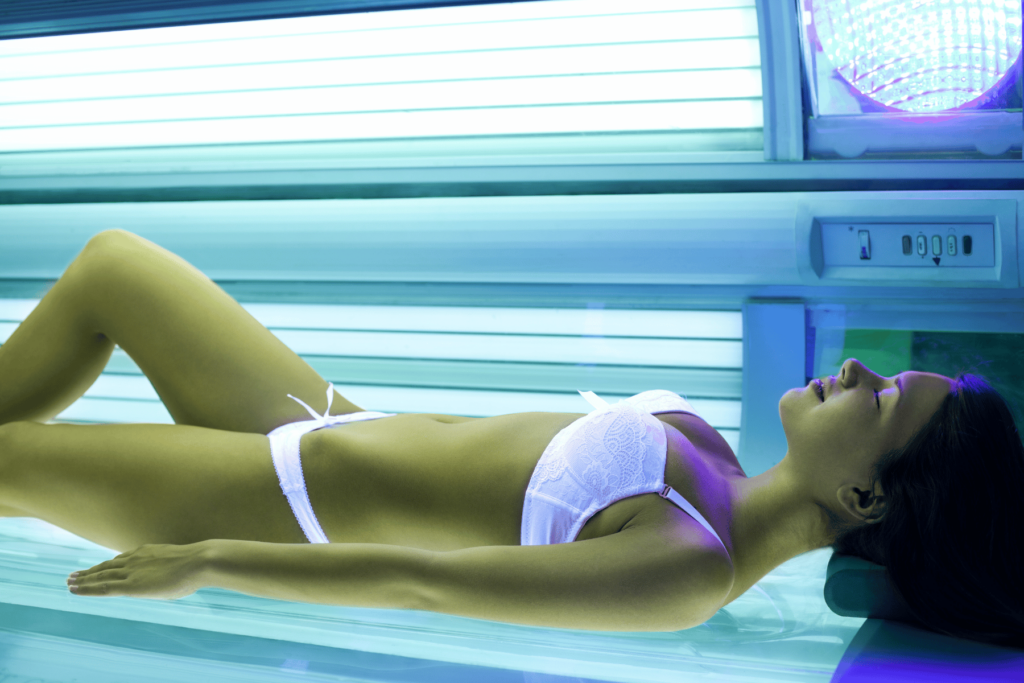
Should I Use Tanning Lotion in a Tanning Bed?
Before you reach for that bottle of tanning lotion, let’s cover the basics.
Tanning Lotion 101
Tanning lotions typically contain a combination of ingredients that promote the production of melanin, the pigment responsible for skin darkening.
Additionally, many tanning lotions are enriched with moisturizers to keep the surface of the skin hydrated during the tanning process.
Benefits of Using Tanning Lotions in Tanning Beds
Accelerated Tanning
One of the primary reasons people opt for tanning lotions is their ability to speed up the tanning process. These different types of lotion often contain ingredients like tyrosine and amino acids that stimulate melanin production, helping you achieve your desired tan more quickly.
Hydration
Tanning beds can be drying to the skin, which may lead to uneven tanning or premature fading of the tan. Tanning lotions with moisturizing ingredients help combat this issue by keeping the skin hydrated and preventing it from becoming overly dry.
Enhanced Color
Some tanning lotions contain bronzers that provide an immediate color boost to your skin, allowing you to see a darker shade as the natural tan develops. This can be especially appealing if you’re looking for instant gratification.
Skin Care
High-quality tanning lotions often include vitamins, antioxidants, and natural extracts that nourish and protect the skin. These ingredients can help counteract the potential damage caused by UV exposure and promote overall skin health.

Considerations and Cautions
Skin Sensitivity
Not all regular tanning lotions are suitable for every skin type. If you have sensitive skin, it’s important to choose a tanning lotion formulated for sensitive or delicate skin to avoid potential irritation.
Potential Allergies
Tanning lotions can contain a variety of ingredients, and some individuals might be allergic to specific components.
Always perform a patch test before applying a new tanning lotion all over your body to ensure that the product is safe for your skin and won’t cause any adverse reactions. Here’s the best way to perform a patch test:
Materials You’ll Need
- Tanning lotion
- Mild soap
- Water
- Clean towel
- Small, inconspicuous area of skin (such as the inside of your wrist or behind your ear)
Steps
- Choose the Patch Test Area: Select a small, inconspicuous area of skin where you’ll perform the patch test. The inside of your wrist or behind your ear are common choices. Make sure the area is clean and free from any existing irritation or open wounds.
- Clean the Area: Gently cleanse the chosen area with mild soap and water. Pat it dry with a clean towel. This step ensures that there are no residual substances on your skin that could interfere with the patch test results.
- Apply a Small Amount of Tanning Lotion: Squeeze a small amount of the tanning lotion onto your finger. You only need a dime-sized amount for the patch test. Avoid spreading the lotion too close to the edge of the patch test area to prevent accidental contact with the surrounding skin.
- Massage the Lotion In: Gently massage the tanning lotion into the patch test area using your finger. Make sure it’s evenly applied and fully absorbed into the skin.
- Observe and Wait: Allow the tanning lotion to sit on your skin for at least 24 hours. During this time, avoid getting the patch test area wet or exposing it to excessive heat or friction.
- Check for Reactions: After 24 hours, examine the patch test area for any signs of irritation, redness, itching, swelling, or rash. If you notice any of these reactions, it’s a sign that you might be sensitive or allergic to the tanning lotion’s ingredients.
Interpreting Patch Test Results
- No Reaction: If there’s no adverse reaction on the patch test area after 24 hours, it suggests that the tanning lotion is likely safe for you to use.
- Mild Irritation: Some mild redness or itching might occur due to the nature of the ingredients. If the irritation is minor and disappears within a short time, it might still be safe to use the product, but you should exercise caution during your first full application.
- Severe Reaction: If you experience significant redness, swelling, intense itching, or a rash during or after the patch test, do not use the tanning lotion. Wash off the product immediately with mild soap and water and avoid using it on your skin.
Remember that everyone’s skin is different, and reactions can vary. If you have a history of allergies or sensitive skin, it’s especially important to perform a patch test before using any new skincare product, including tanning lotion.
UV Exposure
While tanning lotions, and regular lotions, can enhance your tanning experience, they do not provide protection against UV rays. It’s crucial to use a tanning lotion in combination with proper protective eyewear and shorter tanning bed sessions to minimize the risk of overexposure to UV radiation.
If you want to know more about how ultraviolet light interacts with your skin, keep reading.
Quality Matters
Not all tanning lotions are created equal. Opt for reputable brands and products that are designed specifically for use in tanning beds. These products are formulated to interact with the UV light in a tanning bed without causing adverse reactions. (So not, regular lotion is not recommended.)
Using tanning lotion in a tanning bed can indeed offer several benefits. However, it’s essential to choose the right product for your skin type and prioritize responsible UV exposure.
If you’re unsure about which tanning lotion is best for you, consider consulting with a dermatologist or skincare professional before incorporating it into your tanning routine for the best results.

Best Tanning Bed Lotions
Ed Hardy Coconut Kisses
Ed Hardy’s Coconut Kisses contains coconut milk, coconut oil, and cocoa butter to improve skin hydration.
It delivers a dark golden tan without the use of bronzing agents, helps prolong the life and radiance of your tattoos and tanning results, and increases melanin formation to accelerate the tanning process to give you a dark tan.
CLICK HERE TO GET IT ON AMAZON FOR $25.
Australian Gold Rapid Tanning Intensifier
Australian Gold’s Rapid Tanning Intensifying lotion speeds up the tanning process by preparing your skin for dark color development.
It’s enriched with essential oils, Tea Tree Oil, Vitamin E, and Aloe Vera to provide naturally soothing and deeply nourished skin that remains hydrated for a long time.
CLICK HERE TO GET IT ON AMAZON FOR $7.
Millennium Tanning Solid Black
Solid Black allows you to show off your already tanned skin in just one hour after application. The color is long-lasting and acts as a tan extender with no tingling sensations.
Plus, it moisturizes your skin when it’s giving you a darker tan as well.
CLICK HERE TO GET IT ON AMAZON FOR $31.
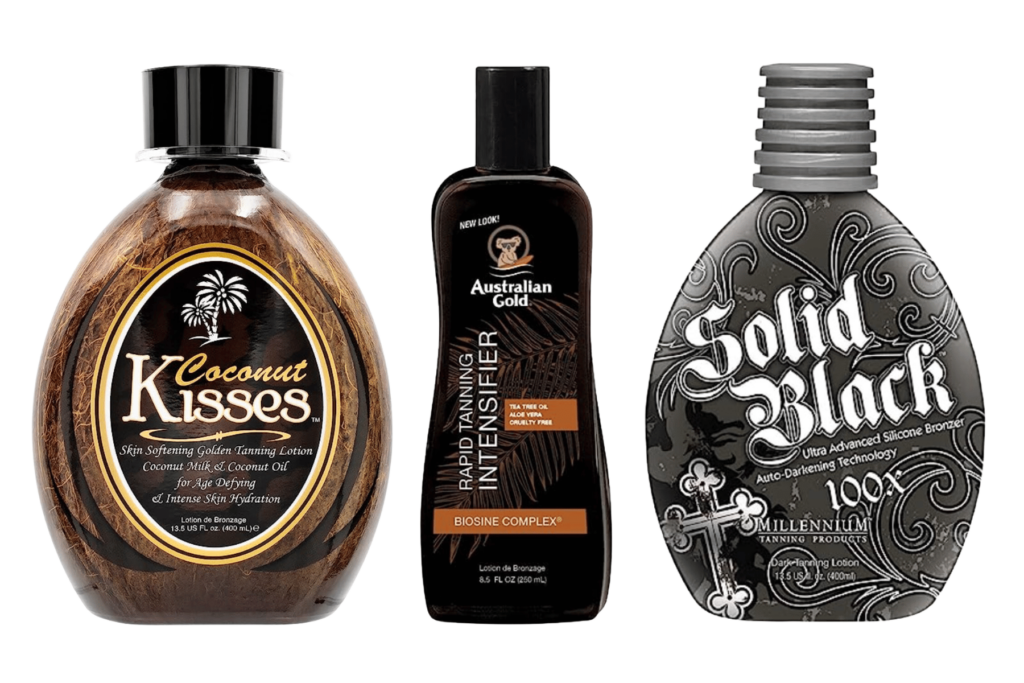
Understanding How UV Light in Tanning Beds Affects Your Skin
The process of tanning, whether outdoors or in tanning beds, involves exposure to ultraviolet (UV) light. Understanding how UV light interacts with your skin is essential for making informed decisions about tanning.
Now, it’s a good idea to delve into how UV light from tanning beds affects your skin and what you need to know to protect your skin’s health.
The Basics of UV Light
UV light is a form of electromagnetic radiation emitted by the sun and artificial sources like tanning beds. It is divided into three main categories based on wavelength: UVA, UVB, and UVC.
UVC is mostly absorbed by the Earth’s atmosphere and is not a significant concern in tanning. This is when outdoor tanning lotions with SPF protection are used, but I won’t get into those here.
UVA and UVB, however, play crucial roles in the tanning process and can impact the skin in various ways.
UVA and UVB in Tanning Beds
UVA Rays
UVA rays penetrate the skin’s deeper layers and are primarily responsible for causing immediate tanning. They can also contribute to the premature aging of the skin, such as the development of fine lines, wrinkles, and age spots.
UVA rays are less likely to cause sunburn compared to UVB rays, but they are still considered a risk factor for skin damage.
UVB Rays
UVB rays are responsible for causing sunburn and play a significant role in the tanning process. They affect the skin’s upper layers and stimulate the production of melanin, the pigment responsible for darkening the skin.
Prolonged exposure to UVB rays without protection can increase the risk of skin damage, including sunburn, premature aging, and potentially skin cancer.
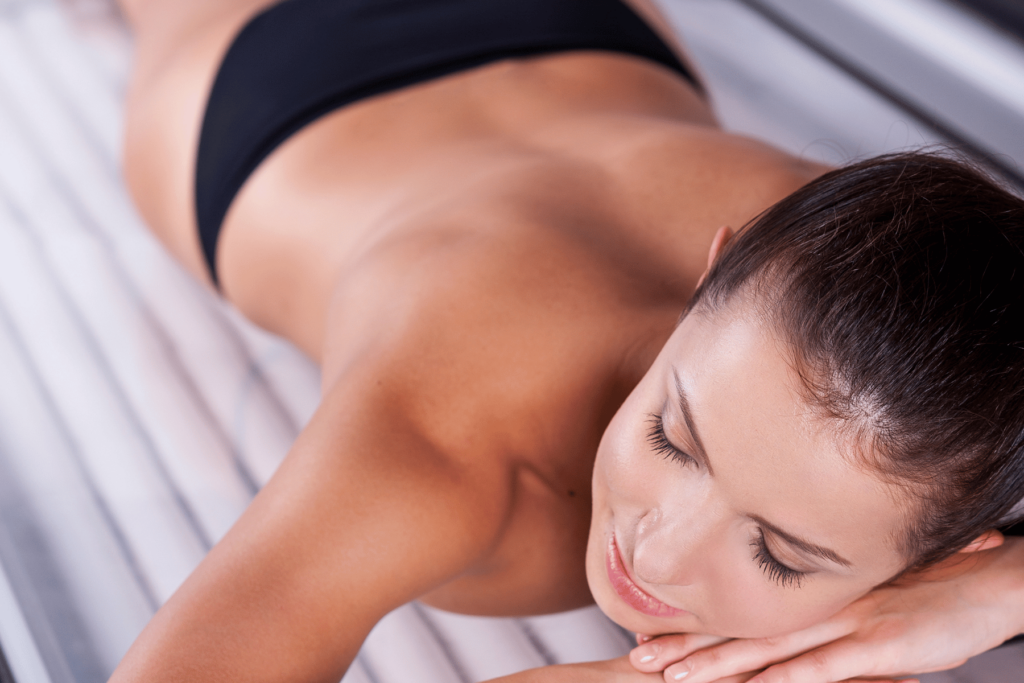
Effects of UV Light on the Skin
Tanning
The skin darkens as a protective response to UV exposure. Melanin production is increased to absorb and minimize the harmful effects of UV rays. However, prolonged or excessive exposure can lead to uneven tans, pigmentation changes, and a heightened risk of skin damage.
Sunburn
Overexposure to UVB rays can cause sunburn, characterized by redness, pain, and skin peeling. Sunburn damages the DNA in skin cells and increases the risk of skin cancer, particularly if sunburns are frequent.
Premature Aging
Both UVA and UVB rays contribute to premature aging of the skin, including the development of fine lines, wrinkles, and age spots. This is due to the breakdown of collagen and elastin fibers in the skin caused by prolonged UV exposure.
Skin Cancer Risk
The most serious consequence of prolonged exposure to UV light is an increased risk of skin cancer. UV radiation can damage the DNA in skin cells, leading to mutations that can result in skin cancer, including melanoma, basal cell carcinoma, and squamous cell carcinoma.
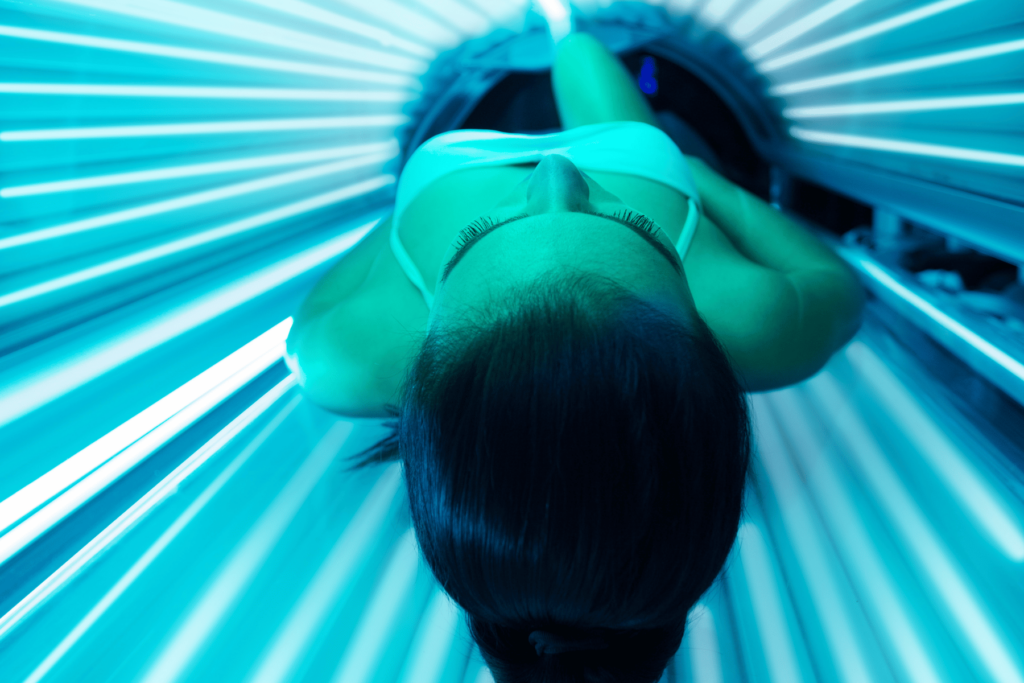
Protecting Your Skin
While tanning beds offer a convenient way to achieve a tan, it’s crucial to prioritize your skin’s health. Here are some essential tips for protecting your skin from the harmful effects of UV light.
Use Sunscreen
If you choose to use a tanning bed, apply a broad-spectrum sunscreen with a high SPF to your skin before tanning. This can help mitigate the effects of UV exposure.
(But let’s be honest – using sunscreen defeats the purpose of paying to hop in a tanning bed.)
Limit Exposure
Avoid prolonged tanning sessions and limit the frequency of your tanning bed visits. Moderation is key to reducing the risk of skin damage.
Protective Eyewear
Always wear protective eyewear designed for tanning beds to shield your eyes from UV radiation.
Check Your Skin
Regularly examine your skin for any changes in moles, spots, or growths. Early detection of skin changes can be crucial in preventing skin cancer.
Consult Professionals
Consider consulting a dermatologist before using tanning beds, especially if you have a history of skin sensitivities, allergies, or a family history of skin cancer.
While tanning can provide a temporary aesthetic result, it’s essential to prioritize your skin’s health and minimize the risks associated with UV exposure. Your skin’s health should always be a priority in your quest for a radiant appearance.
Again, I opt for a spray tan over an indoor tanning bed now. I want to protect my skin and slow the signs of aging. My skin tone is very light and I live in South Florida without a golden glow… but another option is self-tanning lotion.
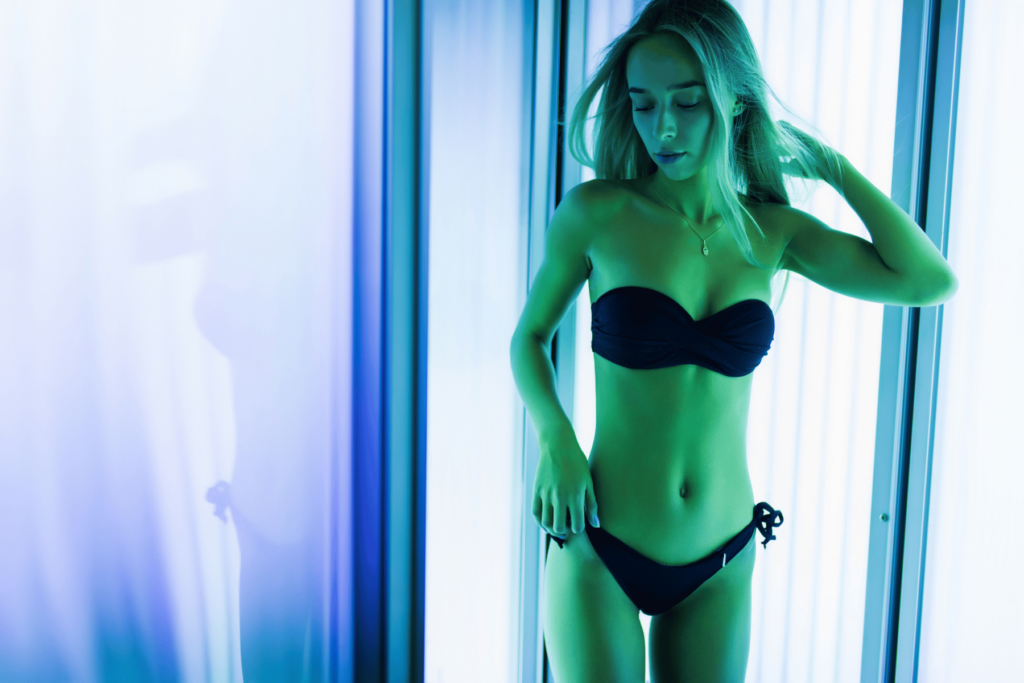
Self Tanning Lotion
Self-tanning lotions RE a safe and convenient way to achieve a beautiful bronzed look without the potential risks associated with UV exposure.
Often referred to as self-tanners or sunless tanners, they contain active ingredients that interact with the top layer of your skin to produce a temporary tan.
Self-tanners work by utilizing Dihydroxyacetone (DHA), a colorless chemical that reacts with amino acids in the skin’s outermost layer to produce a brown pigment, giving you a natural-looking tan.
Choosing the Best Self-Tanning Lotion
The market is flooded with various self-tanning products, each promising a flawless tan. To help you find the best one for your needs, here are some things to consider.
Formulation
Self-tanning lotions come in various formulations, including lotions, mousses, sprays, and gels. Choose one that aligns with your application preference and skin type.
Color Intensity
Different self-tanners offer different levels of color intensity. Opt for a shade that suits your natural skin tone and the depth of tan you desire.
Application Ease
Look for products that are easy to apply and blend evenly. Some self-tanners come with application mitts, which can help achieve a streak-free finish. (You don’t want to walk around with orange hands now, do you?)
Ingredients
Prioritize products with high-quality ingredients that nourish and hydrate the skin while delivering a tan. Aloe vera, coconut oil, and antioxidants are commonly found in self-tanning lotions.
Scent
Some self-tanning products have a distinctive scent due to the reaction between DHA and the skin. Choose a product with a pleasant scent or consider options that have minimized the typical self-tanner odor.
Longevity
The duration of your tan will vary depending on the product. Some self-tanners last a few days, while others can provide a tan for up to a week. Consider your desired tan duration when choosing a product.
Top Picks: Best Self-Tanning Lotions
Jergens Natural Glow
CLICK HERE TO GET IT ON AMAZON FOR $10.
Beauty by Earth Self Tanning Lotion
CLICK HERE TO GET IT ON AMAZON FOR $31.
Bondi Sands Self-Tanning Foam
CLICK HERE TO GET IT ON AMAZON FOR $21.
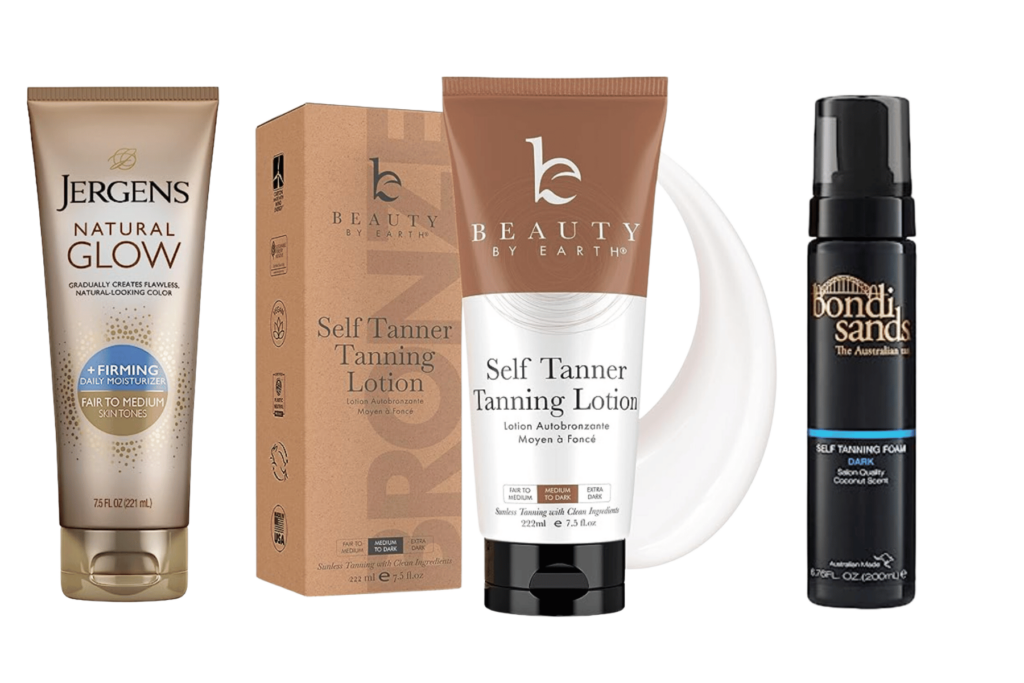
Application Tips
- Exfoliate and moisturize your skin before applying self-tanner to ensure an even application.
- Use an application mitt or gloves to prevent staining your hands.
- Apply the self-tanner in circular motions, starting from your feet and working your way up.
- Pay attention to areas like elbows, knees, and ankles, where the skin is drier and may absorb more product.
- Allow the product to dry before dressing to avoid staining your clothes.
I think I’ve got you covered in the tanning bed, in the spray tan booth, and in the bathroom after a shower.
Follow me on social media @ChristinaAllDay and let me know how you’re keeping your skin tan.
Oh, one more thing. Don’t forget the lip balm.
